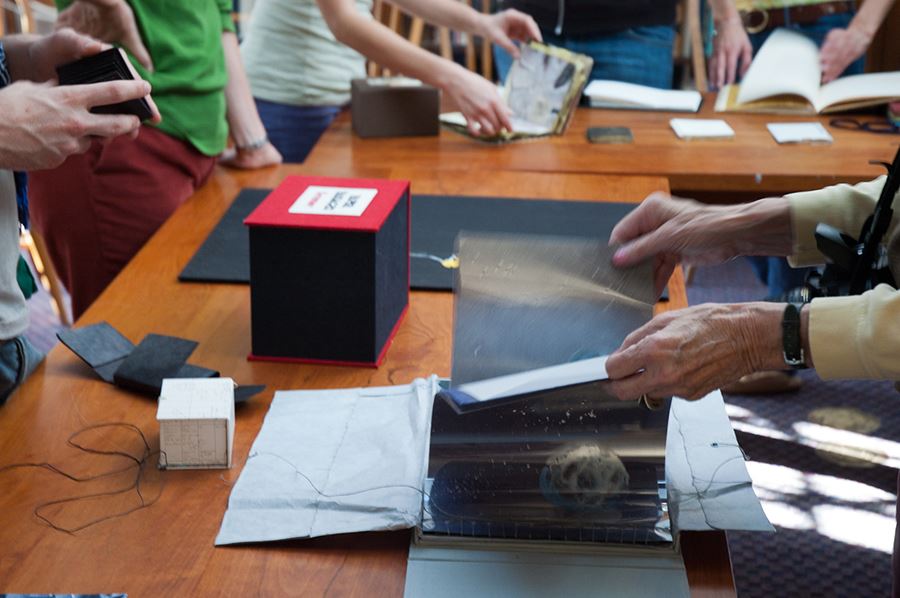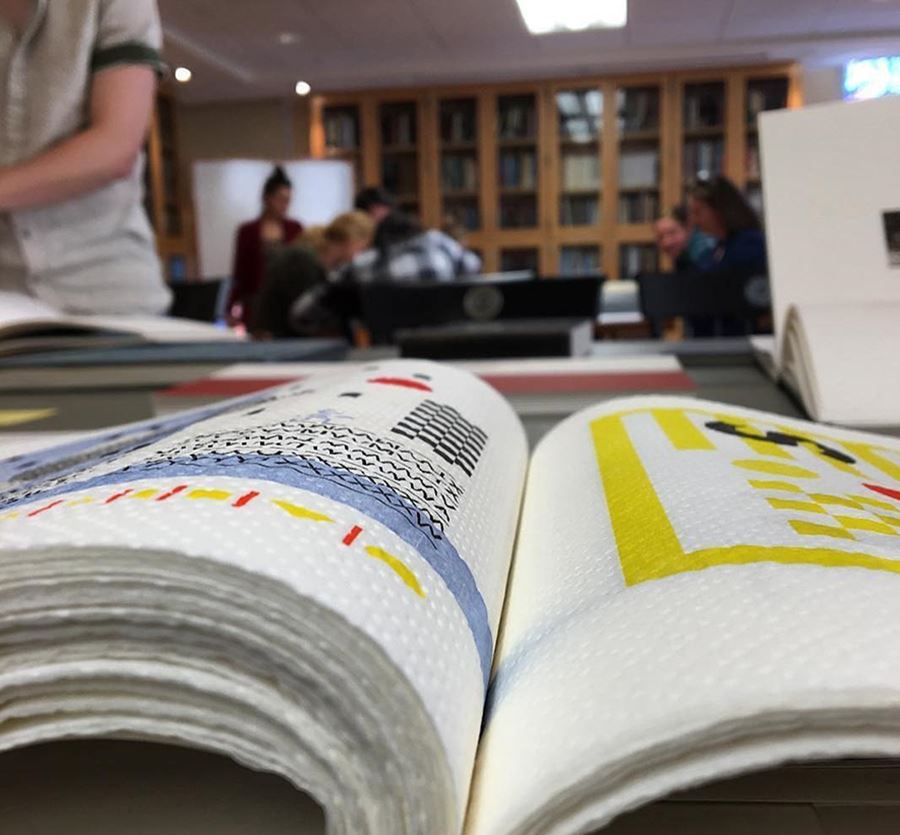Cathleen Miller and Marieke Van Der Steenhoven discuss the artist’s book from the perspective of academic special collections librarians who teach with artists' books. As a potentially transformative site of encounter, Miller and Van Der Steenhoven share their experiences and articulate the pedagogical power specific to artists' books.

Students from the University of Southern Maine engage with artists' books from the Maine Women Writers Collection
Marieke Van Der Steenhoven: What was your first experience with artists' books? What was that encounter like? How does that inform how you interact with them now?
Cathleen Miller: The first time I encountered an artist’s book was in a graduate poetry seminar. My professor took our class to the library’s special collections to look at some of their fine print books, zines, and artists' books. This was probably my first visit to an archive and it was formative as I developed my own work, and later, my career path. I remember the feeling of handling these new (to me) objects. I felt a sense of excitement, possibility, and maybe a bubbling up of joy because finally, I could see a way in which my art-making and my poetry-writing could come together. When I went back to school, I had chosen writing over art. I believed that I could only do one thing—that I had to choose between the things that made me feel most alive. That class—the two hours I spent enchanted in the archives—changed my course as a writer, and arguably changed my whole life course. I try to think of that impact when I bring artists’ books into the classroom; I try to create the possibility of an opening up into some new understanding.
MV: Similarly, I first encountered artists' books in an academic setting, in an undergraduate art history seminar. I had no idea what an artist’s book was, I had never been in a rare book room before, and I did not know what I was walking into. Week after week I returned to the rare book room to look and respond to books, thinking about form, content, and reader experience; by the end of the semester I had interacted with dozens of examples and experienced something transformative that continues to manifest in how I approach my work today. The contemplative, meditative directive wholly informed my interactions with all sorts of objects moving forward. And the framework for that class wholly influences how I teach with artists' books now. There is power in the tangible, contemplative, and exploratory experience of artists' book, and I think we’d both agree in the reading room and classroom.

Romano Hänni's Typo Bilder Buch (2012) and students from Maine College of Art with Bowdoin's book arts collection
CM: How do you teach with artists' books? How does it differ then how you teach with other materials? If there is a distinction, then why does that distinction exist?
MV: I work at a fairly small liberal arts institution and the instruction program I’ve developed emphasizes active learning for information, archival, and visual literacy. The emphasis on active learning places the student at the center of our instruction design, providing the opportunity to engage in hands-on learning to build transferable skills that directly promote students’ academic growth and development. Artist’s books are incredible teaching tools for active learning: the form demands engagement and when well executed, a work forces students to confront what preconceived notions they have about the book: its form, the act/performance of reading, and the transmission of knowledge. Artists' books inherently encourage students (and all readers) to consider how form influences content and vice versa. When I design instruction sessions around artist’s books there may be a bit of introductory material, a few words about handling, and perhaps some guiding questions – but mostly it is giving students the space and time to engage with the work.

Bowdoin College art history students engage with artists' books in Library's special collections classroom
CM: Because the college where I work is not liberal arts, but has more of a focus on science and health care, artists' books are often the means for me to get students into the archives or get the books into their classrooms. The form of the artist’s book is inherently flexible, and the visual nature of the experience provides an opening to have conversations that might not otherwise happen in an environmental science or narrative medicine class. When I bring artists' books into the classroom, I try to guide students in ways of looking at the books as objects since most of them are unfamiliar with this format. I attempt to give students context for the experience, relating it to the reason they are using objects in the classroom. I think the experience of using artists' books is different from interacting with other materials because students have less preconceived notions about what they are and what they mean. There is room for surprise and inspiration. The texts speak differently than, say, diaries or letters or novels. In my opinion, the form demands a different relationship.
MV: I agree, as a pedagogical tool, artists' books open up dialogue. I work with classes across the humanities and social sciences and use artists' books for instruction in visual arts, history, languages, literature, and sociology classes. The form disrupts or resituates conceptions, perceived narratives, and more. Because of their time-basedness and the performative aspects of reading, artists' books also offer a place to acknowledge a sensory experience that is not always present in academic discourse.
Cathleen Miller serves as curator of the Maine Women Writers Collection at the University of New England. She holds an MLS from Drexel University and an MA in English with a concentration in Poetry from Temple University. Cathleen’s poetry has been published in numerous journals and anthologies.
Marieke Van Der Steenhoven is the Special Collections Education and Outreach Librarian at Bowdoin College. Marieke holds a BA in Art History from Smith College and an MA in American and New England Studies with concentration in Public Culture and History from the University of Southern Maine.

